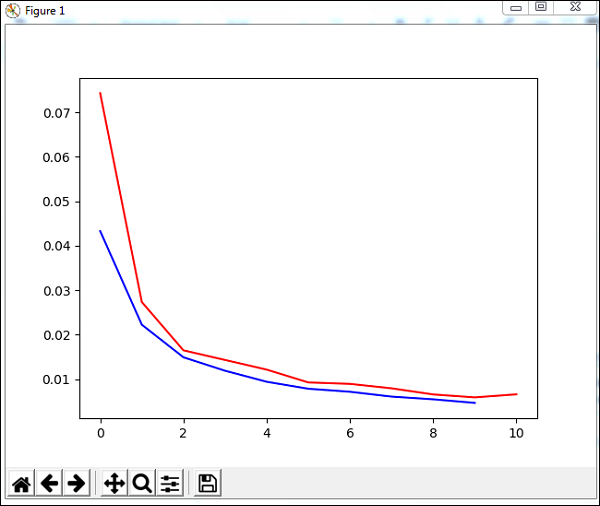
- PyBrain - Home
- PyBrain - Overview
- PyBrain - Environment Setup
- PyBrain - Introduction to PyBrain Networks
- PyBrain - Working with Networks
- PyBrain - Working with Datasets
- PyBrain - Datasets Types
- PyBrain - Importing Data For Datasets
- PyBrain - Training Datasets on Networks
- PyBrain - Testing Network
- Working with Feed-Forward Networks
- PyBrain - Working with Recurrent Networks
- Training Network Using Optimization Algorithms
- PyBrain - Layers
- PyBrain - Connections
- PyBrain - Reinforcement Learning Module
- PyBrain - API & Tools
- PyBrain - Examples
- PyBrain Useful Resources
- PyBrain - Quick Guide
- PyBrain - Useful Resources
- PyBrain - Discussion
PyBrain - Examples
In this chapter, all possible examples which are executed using PyBrain are listed.
Example 1
Working with NOR Truth Table and testing it for correctness.
from pybrain.tools.shortcuts import buildNetwork from pybrain.structure import TanhLayer from pybrain.datasets import SupervisedDataSet from pybrain.supervised.trainers import BackpropTrainer # Create a network with two inputs, three hidden, and one output nn = buildNetwork(2, 3, 1, bias=True, hiddenclass=TanhLayer) # Create a dataset that matches network input and output sizes: norgate = SupervisedDataSet(2, 1) # Create a dataset to be used for testing. nortrain = SupervisedDataSet(2, 1) # Add input and target values to dataset # Values for NOR truth table norgate.addSample((0, 0), (1,)) norgate.addSample((0, 1), (0,)) norgate.addSample((1, 0), (0,)) norgate.addSample((1, 1), (0,)) # Add input and target values to dataset # Values for NOR truth table nortrain.addSample((0, 0), (1,)) nortrain.addSample((0, 1), (0,)) nortrain.addSample((1, 0), (0,)) nortrain.addSample((1, 1), (0,)) #Training the network with dataset norgate. trainer = BackpropTrainer(nn, norgate) # will run the loop 1000 times to train it. for epoch in range(1000): trainer.train() trainer.testOnData(dataset=nortrain, verbose = True)
Output
C:\pybrain\pybrain\src>python testnetwork.py
Testing on data:
('out: ', '[0.887 ]')
('correct:', '[1 ]')
error: 0.00637334
('out: ', '[0.149 ]')
('correct:', '[0 ]')
error: 0.01110338
('out: ', '[0.102 ]')
('correct:', '[0 ]')
error: 0.00522736
('out: ', '[-0.163]')
('correct:', '[0 ]')
error: 0.01328650
('All errors:', [0.006373344564625953, 0.01110338071737218,
0.005227359234093431, 0.01328649974219942])
('Average error:', 0.008997646064572746)
('Max error:', 0.01328649974219942, 'Median error:', 0.01110338071737218)
Example 2
For Datasets, we are going to use datasets from sklearn datasets as shown below: Refer load_digits datasets from sklearn: scikit-learn.org
It has 10 classes, i.e., digits to be predicted from 0-9.
The total input data in X is 64.
from sklearn import datasets
import matplotlib.pyplot as plt
from pybrain.datasets import ClassificationDataSet
from pybrain.utilities import percentError
from pybrain.tools.shortcuts import buildNetwork
from pybrain.supervised.trainers import BackpropTrainer
from pybrain.structure.modules import SoftmaxLayer
from numpy import ravel
digits = datasets.load_digits()
X, y = digits.data, digits.target
ds = ClassificationDataSet(64, 1, nb_classes=10) )
# we are having inputs are 64 dim array and since the digits are from 0-9
the classes considered is 10.
for i in range(len(X)):
ds.addSample(ravel(X[i]), y[i]) # adding sample to datasets
test_data_temp, training_data_temp = ds.splitWithProportion(0.25)
#Splitting the datasets 25% as testdata and 75% as trained data
# Using splitWithProportion() method on dataset converts the dataset to
#superviseddataset, so we will convert the dataset back to classificationdataset
#as shown in above step.
test_data = ClassificationDataSet(64, 1, nb_classes=10)
for n in range(0, test_data_temp.getLength()):
test_data.addSample( test_data_temp.getSample(n)[0], test_data_temp.getSample(n)[1] )
training_data = ClassificationDataSet(64, 1, nb_classes=10)
for n in range(0, training_data_temp.getLength()):
training_data.addSample(
training_data_temp.getSample(n)[0], training_data_temp.getSample(n)[1]
)
test_data._convertToOneOfMany()
training_data._convertToOneOfMany()
net = buildNetwork(
training_data.indim, 64, training_data.outdim, outclass=SoftmaxLayer
)
#creating a network wherein the input and output are used from the training data.
trainer = BackpropTrainer(
net, dataset=training_data, momentum=0.1,learningrate=0.01,verbose=True,weightdecay=0.01
)
#Training the Network
trnerr,valerr = trainer.trainUntilConvergence(dataset=training_data,maxEpochs=10)
#Visualizing the error and validation data
plt.plot(trnerr,'b',valerr,'r')
plt.show()
trainer.trainEpochs(10)
print('Percent Error on testData:',percentError(
trainer.testOnClassData(dataset=test_data), test_data['class']
))
Output

Total error: 0.0432857814358
Total error: 0.0222276374185
Total error: 0.0149012052174
Total error: 0.011876985318
Total error: 0.00939854792853
Total error: 0.00782202445183
Total error: 0.00714707652044
Total error: 0.00606068893793
Total error: 0.00544257958975
Total error: 0.00463929281336
Total error: 0.00441275665294
('train-errors:', '[0.043286 , 0.022228 , 0.014901 , 0.011877 , 0.009399 , 0.007
822 , 0.007147 , 0.006061 , 0.005443 , 0.004639 , 0.004413 ]')
('valid-errors:', '[0.074296 , 0.027332 , 0.016461 , 0.014298 , 0.012129 , 0.009
248 , 0.008922 , 0.007917 , 0.006547 , 0.005883 , 0.006572 , 0.005811 ]')
Percent Error on testData: 3.34075723830735
Advertisements